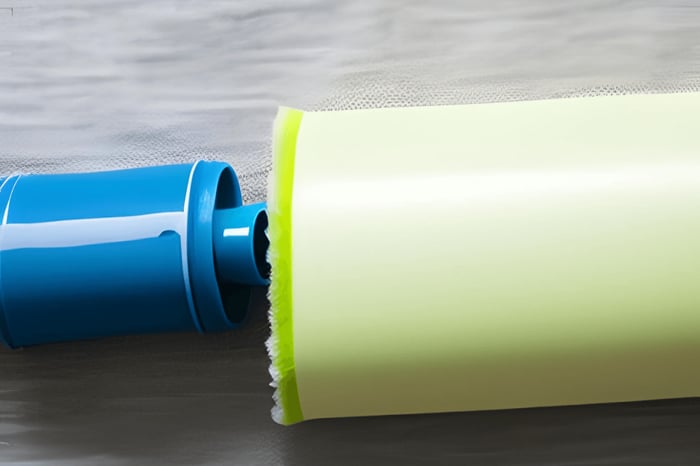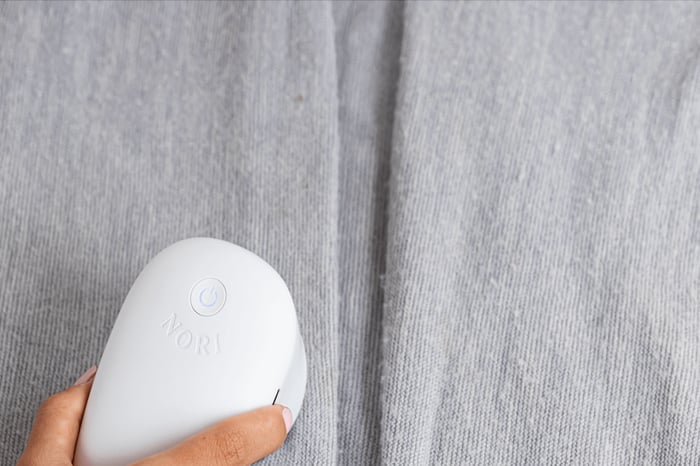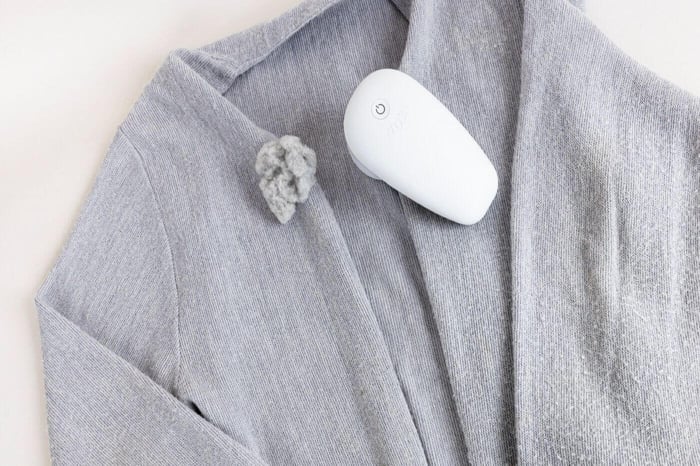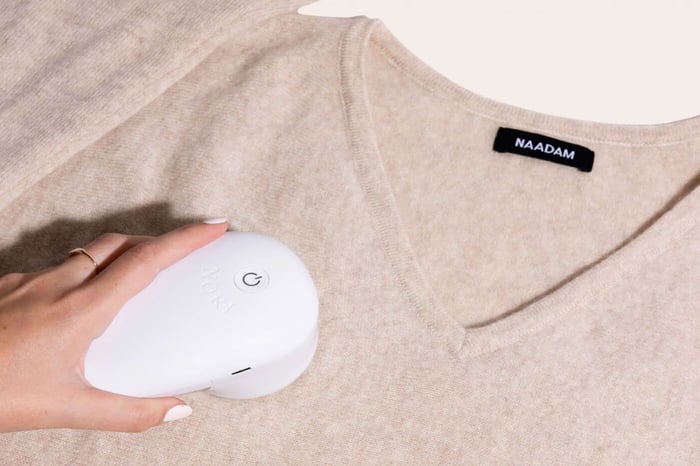
Learning how to clean the lint out of a dryer can feel like an uphill battle. The task may seem daunting, especially if you’ve never done it before. But here’s the thing… Cleaning the lint from your dryer is crucial for its performance and longevity. Lint buildup can lead to fire hazards and reduce dryer efficiency. Not only that… If you don’t know how to clean the lint out of a dryer , you could be putting your home at risk.
The Nori Trim
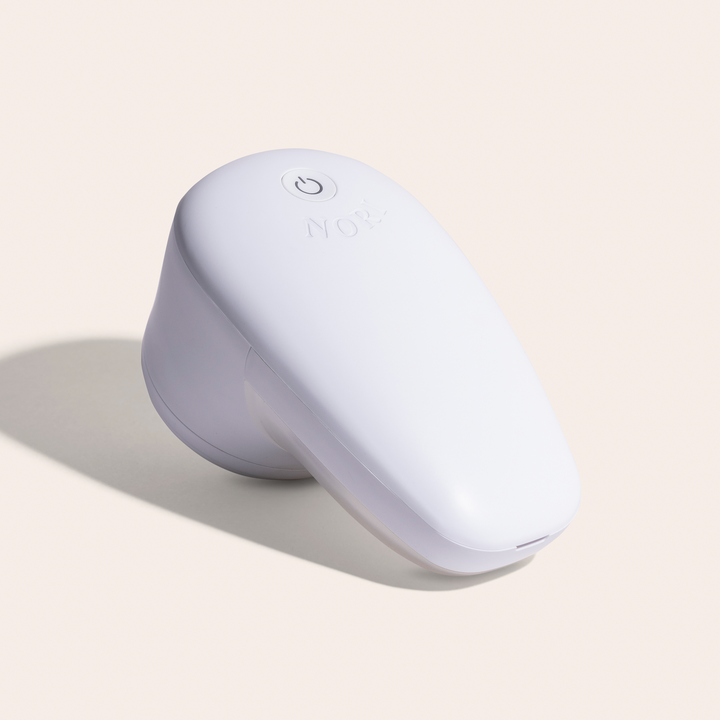
$59.00
A high performance fabric shaver designed to remove pills and lint from clothing and furniture. … read more
Attention: Use discount code "SHOP10" at checkout to save 10% on The Nori Trim!
The Hidden Danger in Your Laundry Room 
It's easy to overlook the laundry room when considering home safety. Yet, your clothes dryer can be a significant risk if not properly maintained.
Your dryer collects small fibers shed from materials during each drying cycle. These particles build up as lint inside your machine's lint trap and vent system - an often overlooked hazard that could lead to serious problems.
Dangers Associated With Dryer Lint Build-Up
Lurking within your gas or electric dryer is accumulated lint which poses more than just fire risks. Lint can escape through tiny gaps around the edges of the dryer drum and fall into the cabinet, potentially causing a fire hazard. A clogged ventilation system due to excess lint leads to inefficient operation of the appliance resulting in higher energy consumption - bad news for both you and our environment.
If hot air gets blocked by these obstructions, it may get redirected into internal parts causing overheating issues damaging components over time thus reducing its lifespan drastically.
Avoiding The Risks Of Accumulated Dryer Lint
To prevent potential disasters associated with built-up lint, regular cleaning becomes essential. Keeping the dryer duct free of lint and debris is crucial to ensure proper airflow and efficient drying. Cleaning out your dryer’s performance after every load should become part of routine maintenance along with periodic deep clean sessions targeting hard-to-reach areas like ducts behind machines where stubborn deposits tend gather unnoticed over extended periods of usage.
Keeping your dryer’s lint trap and vent system clean is a simple task that can be done with the right tools. These include a vacuum cleaner, nylon brush, vent brush, mild dish soap or liquid detergent.
If you’re up to the challenge of deeper cleaning tasks in your laundry room, there are additional resources available such as specialized dryer maintenance kits. Now let’s delve into these essential tools one by one.
Choosing the Right Lint Brush
Selecting an appropriate lint brush isn't rocket science but it does require some thoughtfulness on the part of the homeowner - particularly when considering factors like size, bristle stiffness, and handle length.
The first step is ensuring compatibility between the chosen tool and the specific model of your clothes dryer: small enough to navigate narrow spaces yet large enough to effectively remove excess lint from inside the drum or other hard-to-reach areas around gas lines (in case you have a gas-powered unit).
Bristle stiffness matters too - overly stiff brushes could potentially scratch delicate surfaces while excessively soft ones may not pick up all debris properly. Handle length plays a role in ease-of-use; longer handles provide better reach whereas shorter ones offer more control during detailed work on smaller components located near the back panel, etc., so choose wisely.
Using a Vacuum Cleaner for Dryer Maintenance
A good old-fashioned vacuum cleaner with a hose attachment often proves invaluable when it comes down to removing stubborn bits stuck within those difficult-to-access spots where hand-held brushes cannot easily reach, e.g., behind the drum or around internal hardware components close to gas lines (if applicable).
Cleaning the lint trap of your dryer is a task that shouldn’t be overlooked. It’s essential to clean the lint trap of your dryer for more than just keeping it running well; it can also reduce the risk of fires.
Removing Lint from Clothes Dryer
The first step in this process involves taking out the lint screen from its slot within your machine. This component can typically be found either on top or inside the door opening for most dryers. It is important to clean the dryer lint trap after every load to ensure the dryer functions optimally. Once you’ve removed it, gently peel off any excess lint clinging onto its surface.
If there are stubborn bits refusing to come off easily, don’t worry. A good quality nylon brush comes handy here as they help dislodge and collect these pieces without causing damage to your screen. Ensure both sides get a thorough cleaning for optimal results.
Cleaning Technique if Your Dryer Has a Front Access Panel
In case you own one of those models featuring front access panels instead of top ones, brace yourself for some extra steps while cleaning up. The very first thing before starting anything else: unplug that machine.
It is important to clean the dryer exhaust duct by using a hose attachment on a vacuum cleaner to suction around the entrance of the vent and poke it inside the dryer exhaust duct. You might have to unscrew some parts or even remove clips so as to gain access into internal components like drum and back panel where more dust and fiber buildup happens over time than other areas generally do. Consumer Reports suggests using an attachment designed specifically for appliances which provides better suction control during such delicate tasks ensuring all traces are effectively gone leaving no room for possible risks associated with their presence.
The Nori Trim

$59.00
A high performance fabric shaver designed to remove pills and lint from clothing and furniture. … read more
Attention: Use discount code "SHOP10" at checkout to save 10% on The Nori Trim!
Cleaning Inside Your Gas Or Electric Dryer With Liquid Detergent And Warm Soapy Water
Cleaning gas and electric dryers requires special care due to the complex machinery involved. It is crucial to clean the lint filter before each load to prevent lint buildup and improve dryer efficiency.
After unplugging the unit, prepare warm soapy water by mixing mild dish soap or liquid detergent with hot water until suds form, then start scrubbing.
Using a soft cloth dipped in the solution, wipe down interior surfaces including drum walls and door seals, making sure no residue is left behind.
If stains persist, consider a vinegar solution (1 cup white vinegar mixed with 1-gallon warm water) as a natural alternative. Be careful when applying it directly to electronic elements and sensors present within the device to avoid damaging them.
Rinse well afterward and make sure no leftover soap remains. Leave the dryer open to allow air circulation, facilitating complete drying before the next usage cycle begins. This prevents mold growth and contributes towards a longer lifespan and improved performance overall. Finally, remember to reinsert the cleaned and dried-up filter securely into its designated slot, completing a successful deep cleaning session.
Remember, practice makes perfect. Hence, regular maintenance ensures optimal functioning, extending durability, and saving on costly repairs in the long run. Besides, it keeps the laundry room a safe space for everyone to enjoy.
Keep your dryer running smoothly and safely by regularly cleaning the lint trap, using a nylon brush for stubborn bits. If you have a front access panel model, be ready to unscrew parts to reach dust-prone areas. For gas or electric dryers, use warm soapy water or vinegar solution for deep cleaning without damaging electronics. Always rinse well and let it air-dry before reusing.
Cleaning Inside Your Dryer
When it comes to maintaining your dryer’s performance, cleaning the inside of either a gas or electric model is paramount. Accumulated lint can not only hamper efficiency but also pose significant fire risks. Lint removal from the dryer and its exhaust areas is crucial to prevent fire hazards and improve dryer efficiency.
Deep Clean with Liquid Detergent
A deep clean using liquid detergent offers an effective way to tackle stubborn stains and residues that may have built up from fabric softeners or dryer sheets in your washing machine or clothes dryer. Always unplug the appliance before you start any cleaning process for safety reasons.
Create a soapy solution by mixing mild dish soap or liquid laundry detergent into warm water until suds form. Use this mixture along with a soft cloth to gently scrub interior surfaces such as the drum and door seal.
Rinse thoroughly afterwards using another damp cloth - we want no traces of soap residue left behind which could potentially stain future loads of laundry. Once all parts are rinsed, dry them completely prior to reconnecting the power supply and resuming normal use.
Safety Precautions During Cleaning
The first rule when embarking on any maintenance task involving appliances is to unplug the device beforehand and ensure children stay away while work is being carried out due to potential hazards like sharp edges exposed during deeper cleanses.
Steer clear of flammable cleaners and gasoline aerosol sprays, as they might ignite under high heat conditions commonly found within these machines.
Finally, remember that although most people feel comfortable performing basic tasks themselves, if there's ever doubt about whether something should be done professionally, don't hesitate to contact experts who specialize in maintaining home appliances, including washers and dryers.
Safety should be the highest priority, even when it comes to seemingly trivial home tasks; for nothing is more vital than our wellbeing and those we care about.
Keep your dryer running smoothly and safely by regularly cleaning the inside, using a soapy solution of mild detergent. Always unplug before you start, rinse thoroughly after washing, and dry all parts completely. If in doubt about any part of the process, don't hesitate to call in professionals.
Maintaining Your Dryer Vents And Ducts
When it comes to the performance of your dryer, a crucial factor is the state of its vents and ducts. Dryer vent cleaning is essential in preventing lint buildup, improving dryer efficiency, and reducing the risk of house fires. Accumulated lint in these areas can obstruct airflow, causing your appliance to work harder than necessary. This not only affects efficiency but also poses potential fire risks.
Cleaning out your dryer’s lint trap isn’t enough; comprehensive maintenance requires attention to the entire vent system as well. Here are some steps you might find helpful:
-
Finding Your Dryer’s Exhaust Vent: This component is typically located at either side or backside of your machine.
-
Removing Protective Plastic Covers: Aim for careful removal without damaging any parts during this process.
-
Pipe Disconnection: You should always ensure that you’ve unplugged your dryer before starting with disconnections for safety reasons.
-
Vent Brush Cleaning: The goal here is thorough cleaning by inserting and twisting a vent brush into each end of the ductwork until all excess lint build-up inside has been successfully removed.
Importance Of Regular Vent Maintenance
If there was ever an ideal time to maintain regular upkeep on clothes dryers’ vents, now would be it. The U.S Fire Administration suggests homeowners clean their appliances once every couple of years - this practice significantly reduces home fires caused by dryers annually, which accounts for over 15k incidents according to recent statistics from the National Fire Protection Association (NFPA). Maintaining a clean dryer vent is crucial to ensure the efficiency and safety of the dryer.
Beyond reducing risk factors associated with house fires largely due to accumulated dryer lint within ventilation systems, regular upkeep ensures optimal functioning appliances too.
The moment you get started maintaining a clear path that allows hot air to escape easily during the operation cycle, you enhance the overall energy efficiency of the unit itself, leading to lower utility bills in the long run.
However, we understand if some folks feel uncomfortable performing these tasks themselves. In such cases, don’t hesitate to hire professionals who specialize in maintaining appliances like dryers - they’re equipped with the knowledge and tools needed to ensure effective results while keeping safety paramount.
Don’t let your dryer work harder than it has to. Keep the vents and ducts lint-free for optimal performance, lower utility bills, and most importantly - safety. Remember: cleaning out the lint trap isn’t enough; thorough vent system maintenance is key. If you’re unsure about doing it yourself, hire professionals.
When To Call In The Pros
Cleaning a dryer’s lint trap and maintaining its performance may seem like simple tasks, but they can be daunting for some. Cleaning the exhaust hose is crucial to prevent lint buildup and improve dryer efficiency. It’s completely normal to feel uncomfortable handling these chores yourself. After all, not everyone is handy with appliances or has the time to dedicate towards regular maintenance.
In fact, there are times when reaching out for professional help isn’t just convenient—it might even be necessary.
The Signs That Indicate Professional Help Is Needed
If you're hearing unusual noises from your dryer—like grinding or squealing sounds—or if you notice an unpleasant burning smell during operation, those could indicate serious issues that need immediate attention. These aren't problems you should attempt solving on your own unless you have relevant experience in appliance repair.
Besides these obvious signs of trouble, excessive amounts of lint around your laundry room—even after cleaning the lint screen and vent system—are also cause for concern. This could suggest deeper complications within the machine's exhaust system which require expert intervention.
Finding Reliable Appliance Service Technicians
Finding reliable service technicians who specialize in maintaining dryers doesn't have to be a challenging task though. You can start by asking friends or family members about their experiences with local services.
Another great way is through online reviews where customers share their honest opinions about different businesses including those specializing in appliance repairs. Yelp, for instance, is one such platform known for providing comprehensive customer feedback across a wide range of industries. This will give a clear picture regarding reliability, service quality, and cost-effectiveness offered by various companies, thereby aiding the decision-making process.
Making An Informed Decision: DIY Vs Hiring Professionals
When it comes to cleaning a dryer's lint trap and maintaining its performance, there may come a time when you need to decide whether to tackle the task yourself or call in the pros. Here are some factors to consider:
-
Expertise: If you're not comfortable or experienced with handling appliances, it may be best to leave it to the professionals. They have the knowledge and skills to properly clean and maintain your dryer.
-
Time: Regular maintenance of your dryer is important, but it can be time-consuming. If you don't possess the time to devote to this task, employing specialists can help save both energy and hours.
-
Signs of Trouble:If you're experiencing unusual noises or smells coming from your dryer, it's a sign that something may be wrong. In these cases, it's best to call in professionals who can diagnose and fix the issue.
-
Cost:While hiring professionals may come with a cost, it's important to weigh the cost against the potential damage that could occur if the issue is not properly addressed.
Ultimately, the decision to DIY or hire professionals depends on your comfort level, availability of time, and the severity of the issue. Remember, proper maintenance of your dryer can improve its performance, prevent fires, and extend its lifespan.
Don't sweat the small stuff, or in this case, lint. If your dryer is making strange noises, emitting a burning smell, or still has excessive lint despite cleaning efforts - it's time to call in the pros. They'll save you time and potentially costly damage.
FAQs in Relation to How to Clean the Lint Out of a Dryer
How do you clean the lint out of a dryer?
Cleaning lint from your dryer involves removing and washing the lint trap, vacuuming excess lint from hard-to-reach areas, and periodically deep cleaning with mild soap or detergent.
What is the best way to clean lint from the dryer vent?
The most effective method for cleaning a dryer vent includes locating and disconnecting the exhaust pipe, then using a specialized vent brush and vacuum cleaner to remove the lint from the dryer exhaust duct, interior, and back part.
The Nori Trim

$59.00
A high performance fabric shaver designed to remove pills and lint from clothing and furniture. … read more
Attention: Use discount code "SHOP10" at checkout to save 10% on The Nori Trim!
Conclusion
Cleaning the lint out of a dryer is more than just housekeeping, it's about safety and efficiency. With regular maintenance, you can keep your laundry room safe from potential fire hazards caused by accumulated lint.
The right tools like a vacuum cleaner, nylon brush, or even a vent cleaning kit can make this task much easier. Remember to clean not only the lint trap but also the inside of your dryer for optimal performance. Maintaining your vents and ducts regularly, as suggested by the U.S. Fire Administration, reduces the risk of home fires annually.
If all these seem overwhelming or if you're unsure about any step in the process, don't hesitate to call in professionals who specialize in maintaining appliances like dryers.
Your clothes are an investment worth protecting too! By keeping your dryer free from excess lint build-up, you prevent pilling on clothes, thus extending their lifespan.
If you prefer to remove the lint before washing your clothes, try the Nori Trim to save the hassle of cleaning the lint out of your dryer. Get your Nori Trim today!
Want more tips on how to care for your garments? Visit Nori, where we share expert advice on preventing and removing pilling from clothing items. You'll be surprised at how simple changes can significantly improve the longevity of your favorite pieces!

